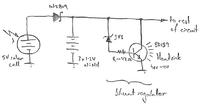swimfan24k
Newbie level 4
Hey, I was hoping I could get some help with a project that I hope to finish in the next couple of months... I have searched the depths of the internet, and have not been able to find any help on this at all!
Simply, I am looking to build a recharging circuit for 3x1.2V NiMh batteries (3.6V total) which are fueled by a single 5V solar cell (700mA output max).
The one function on this recharger that I want, and am not sure if this is even possible, is to install a regulator which would begin charging the batteries once they got to a certain low voltage (i.e. 2V), and then would stop charging the batteries once they got to a certain high voltage (i.e. 4V). Is there a name for this type of IC? or could anyone give me some guidance as to how this could be done?
Would be greatly appreciated!!
S
Simply, I am looking to build a recharging circuit for 3x1.2V NiMh batteries (3.6V total) which are fueled by a single 5V solar cell (700mA output max).
The one function on this recharger that I want, and am not sure if this is even possible, is to install a regulator which would begin charging the batteries once they got to a certain low voltage (i.e. 2V), and then would stop charging the batteries once they got to a certain high voltage (i.e. 4V). Is there a name for this type of IC? or could anyone give me some guidance as to how this could be done?
Would be greatly appreciated!!
S

